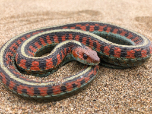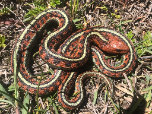California Red-Sided Garter Snake (T.s. infernalis)
Description: Thamnophis sirtalis infernalis features a basic pattern of three stripes including yellow or blue stripes over a primarily red body, with a row of black spots or blotches appearing in a stripe like pattern. The red can be more or less prominent depending on the specimen but appears in blotches and spots across the body and over the head. In some cases, the red may be less prominent, and the snake appears to be black with red markings. However, T. s. infernalis can be easily distinguished from the San Francisco garter snake (Thamnophis sirtalis tetrataenia), which has similar coloring, as it features red blotching and spots, rather than a single strip of red along the dorsal stripe.
The subspecies features an orange or red head, and can vary significantly in appearance based on the geographical location of the snake.
The California red-sided garter snake is a slender snake that is smaller and lighter than the San Francisco garter snake. Females typically reach 35 to 39 inches while males typically reach 25 to 29.5 inches, and are markedly thinner than females. While the recorded maximum size for T. sirtalis as a species is 53.9 inches, it is uncommon to find a female T. s. infernalis over 39.5 inches.
Habitat: Thamnophis sirtalis infernalis is typically associated with permanent or near-permanent bodies of water such as marshland, shallow water, and dunes. The sag ponds in the San Andreas Fault rift zone and freshwater coastal marshes are their primary habitat. T. s. infernalis also temporarily occurs in grassland and some woodland.
Range: Thamnophis sirtalis infernalis occurs throughout California and is found primarily in coastal dunes and marshes. The distribution is disjunct, as it is found ranging from coastal Humboldt County to coastal Monterey County, and is found in conjunction with some San Francisco garter snakes. However, T. s. infernalis was primarily replaced by another subspecies of the common garter snake, the valley garter snake (T. s. fitchi), in southern Monterey, meaning that they are absent from Monterey to Santa Barbara, but present from Santa Barbara to San Diego County. The subspecies was listed as endangered in the U.S. Endangered Species Act (USESA) of 1967, and listed as declining by the United States Fish and Wildlife Services in 1990.
Found in these States:
CA
Diet: The California red-sided gartersnake feeds mainly on small mammals, amphibians, fish, reptiles, slugs, earthworms, leeches, birds and birds eggs.
They are also able to kill and eat adult Pacific newts (Taricha) which are deadly poisonous to most predators. They also store the newt's toxin to protect themselves against predators.
Reproduction: Thamnophis sirtalis infernalis is a viviparous snake, and they mate in the late winter to early spring. Live young are born in the mid-summer to early fall and are typically 5 to 8 inches in length. Clutch sizes vary, but typically vary from 8 to 20 young. Like the red-spotted garter snake (T. s. concinnus), juvenile T. s. infernalis are born with faint colors, which grow increasingly brighter as the snake matures and sheds. Most juveniles are born yellow and become successively more blue as the snake matures and sheds.
Status: The California Department of Fish and Game lists the California Red-Sided Garter Snake as a California Species of Special Concern. Small range along the coast of southern California; has disappeared from 75% of the historically occupied localities; threatened by habitat loss and degradation resulting from urbanization, agriculture, and flood control, and by introduced predators.
»» Kingdom: Animalia - Animals
»» Phylum: Chordata - Chordates
»» Subphylum: Vertebrata - Vertebrates
»» Class: Reptilia - Reptiles
»» Order: Squamata - Scaled Reptiles
»» Suborder: Serpentes
»» Superfamily: Colubroidea
»» Family: Colubridae - Colubrids
»» Genus: Thamnophis
»» Species: Thamnophis sirtalis - Common Garter Snakes
»» Subspecies: T.s. infernalis - California Red-Sided Garter Snake
This article uses material from the Wikipedia article "California Red-Sided Garter Snake ", which is released under the Creative Commons Attribution-Share-Alike License 3.0. Content may have been omitted from the original, but no content has been changed or extended.
|













